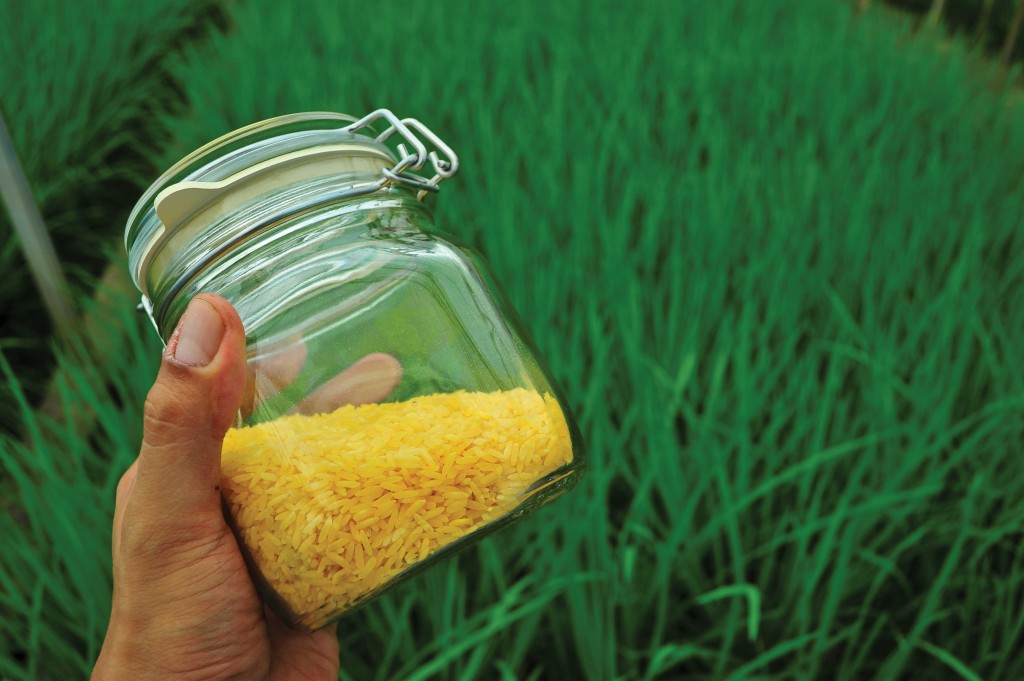GOLDEN RICE
TEMPERS FLARE OVER VITAMIN-ENRICHED GMO
BY TYLER DIFLEY
More than 15 years after its creation, Golden Rice continues to have a polarizing reputation. For some, it is a miracle food and scientific triumph, while others view it as dangerous, unproven and a threat to food security in developing countries.
Golden Rice is a genetically modified organism (GMO) that has been altered to produce high levels of beta-carotene, which the human body converts into vitamin A. In normal rice varieties, the leaves produce and store beta-carotene, while the edible grain does not. The current version of Golden Rice, which produces and accumulates beta-carotene in the grain, was created using genes from maize (corn) and a common soil bacterium.
Adrian Dubock, executive secretary of the Golden Rice Humanitarian Board, uses a literary analogy to explain this gene transfer process. “It’s really taking a word from one book and putting it into another book, and you can understand both the words, and the sentence that the word is a part of still makes sense,” he said.
The presence of beta-carotene in the grain is what gives Golden Rice its yellow or “golden” colour. The compound is also found in many yellow- and orange- coloured fruits and vegetables, such as carrots and sweet potatoes, and in green, leafy vegetables.
European scientists Ingo Potrykus and Peter Beyer developed Golden Rice in the late 1990s to combat rampant vitamin A deficiency (VAD) in the developing world, especially among young children. According to the World Health Organization (WHO), the condition afflicts roughly 250 million preschool-aged children and causes an estimated 250,000 to 500,000 children to go blind every year, with half dying within 12 months of losing their sight.
“It’s the biggest killer of children in the world,” said Patrick Moore, Greenpeace co-founder turned chair of the Allow Golden Rice Society.
With a similar sentiment of wanting to help those less fortunate, Potrykus said his fight is with two giant issues: poverty and malnutrition.
“I was inspired by my promise to make this technology available to the poor,” Potrykus said. “I have invested a considerable part of my scientific career in producing provitamin-A rice with the intention that I wanted to help reduce vitamin A deficiency with all its consequences.”
Potrykus and Beyer licensed their discovery to Syngenta for commercialization with one important stipulation: Syngenta had to offer the crop free of charge for humanitarian use in the developing world, where about 3.5 billion people derive 80 per cent of their daily calories from rice.
“Many of those people have hardly anything else in their diet,” Moore said, explaining that although several vitamin-A-rich vegetables are grown in the developing world, they are often expensive and too low in calories to be a cost-effective source of nutrition. “If they have to choose between rice and vegetables, and they choose vegetables, they’d starve to death.”
By 2004, Syngenta abandoned its research and donated the information to the Golden Rice Humanitarian Board, which is still operating the project today.
Due to its GMO status, Golden Rice spawned a wave of fierce opposition from anti-GMO and environmental organizations, including Greenpeace, GMWatch and Friends of the Earth.
“At present, our position is that we are against the use of Golden Rice,” said Wilhelmina Pelegrina, a senior campaigner for Greenpeace International based in the Philippines, an island country many Golden Rice boosters see as a likely location for the crop’s debut. “We are almost certainly going to go to the Philippines before anywhere else,” Dubock said.
The Philippines is an ideal location, he added, because the country has already registered several GMO crops and, between the International Rice Research Institute and the Philippine Rice Research Institute, possesses a tremendous amount of rice expertise. As a result, the country has become a battleground for the Golden Rice debate.
Greenpeace continues to err on the side of caution, Pelegrina said, because of environmental and safety issues that could be caused by the introduction of Golden Rice.
“There are cases of contamination that have been documented in rice,” she said. “As well as the possible dramatic impacts to farmers, who will lose possible markets for their exports if some of this contaminated material is transported to the European Union.”
The EU has a strict policy on GMOs and closely monitors all such crops that enter its borders. Currently, there are 50 GMO crops authorized in the EU, including different varieties of maize, cotton, sugar beets, rapeseed and soybeans. Most of these GMOs are imported then processed for food and feed end uses. Currently, only one GMO is authorized for cultivation in the EU, a pest-resistant maize variety called MON810.
Although cautious about GMOs, Greenpeace promotes other solutions to micronutrient deficiencies and malnourishment in the developing world that aim to address the underlying causes of these problems.
“It’s more of the long-term solutions that we’re advocating,” Pelegrina said. “It’s really looking at access to diverse diet and promoting diversity, especially ecological agriculture.”
Ecological agriculture involves using bio-diverse farming practices or intercropping, organic pest controls and natural fertilizers in place of monocultures, pesticides and synthetic fertilizers. Greenpeace maintains that these practices could improve access to diverse diets among both rural and urban communities to combat micronutrient deficiencies, including VAD.
The Canadian Biotechnology Action Network (CBAN) takes a similar stance on the issue. Taarini Chopra, a researcher with CBAN, said supporters of Golden Rice are missing the big picture.
“The big-picture solution, the real problem here, is not VAD,” she said. “VAD is very serious, its implications are very serious, but it is not an isolated issue. It is a symptom of wider food insecurity problems.”
These problems can be addressed in the long-term by improving land access and infrastructure support, Chopra said.
“Most of the time, in the communities that are dealing with malnutrition issues, it’s not the lack of food that’s the issue. It’s an inability to access the already available food.”
CBAN also views Golden Rice as a waste of money that could be better spent on proven short-term measures to counter VAD, such as supplementation and food fortification.
“There are some very cost-effective, efficient solutions that have been around for awhile, which need more resources for extension,” Chopra said. “We’re spending hundreds and hundreds of millions of dollars to produce a technological response to a problem that isn’t a technology problem.”
For Potrykus, criticism of Golden Rice’s ability to address the underlying causes of VAD is misguided because this was never its goal in the first place.
“We have developed it to reduce VAD and that’s what it can do very effectively,” he said. “It is not a silver bullet. We never claimed it’s a silver bullet to solve all problems around micronutrient deficiency. But it is an effective measure to do what we have promised to do.”
Instead, Potrykus sees Golden Rice as a complement to existing methods of VAD reduction.
“Programs of food supplementation or vitamin A capsules depend on infrastructure and other resources and funding,” Dubock said. “The reason we still have so many people dying and going blind as a result of VAD is because those interventions don’t reach everybody for different reasons.”
And those who want to see Golden Rice being planted regularly still balk at the anti-GMO contingent.
“It’s been demonstrated many, many times that all this opposition is emotional, ideological and has nothing to do with science,” Potrykus said.
“What could be more natural, what could be more organic, than the plants making their own nutrition from their own genomes?” Dubock asked, taking the debate a step further.
Because of the opposition, and the series of regulatory hurdles that still need to be cleared, Golden Rice has not been released. Field trials are ongoing in locations throughout Indonesia, Bangladesh and the Philippines. However, due to some setbacks—including the destruction of a Philippine test plot in August of 2013—the final variety is not yet complete and agronomic data is still being collected.
For Moore, it’s about looking ahead to what might come next by stacking different traits into the rice.
“You can basically turn a grain of rice into a vitamin pill by using genetics, and that is sustainable,” he said.







Comments